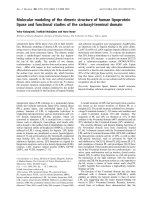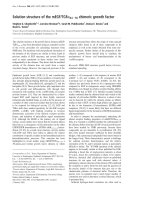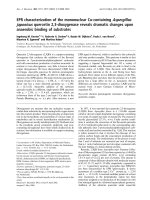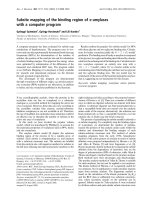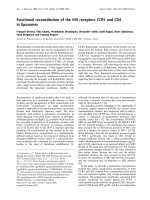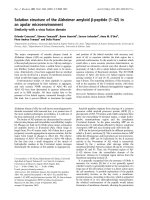Báo cáo y học: " Experimental ablation of the pancreas with high intensity focused ultrasound (HIFU) in a porcine model"
Bạn đang xem bản rút gọn của tài liệu. Xem và tải ngay bản đầy đủ của tài liệu tại đây (722.63 KB, 7 trang )
Int. J. Med. Sci. 2011, 8
9
I
I
n
n
t
t
e
e
r
r
n
n
a
a
t
t
i
i
o
o
n
n
a
a
l
l
J
J
o
o
u
u
r
r
n
n
a
a
l
l
o
o
f
f
M
M
e
e
d
d
i
i
c
c
a
a
l
l
S
S
c
c
i
i
e
e
n
n
c
c
e
e
s
s
2011; 8(1):9-15
© Ivyspring International Publisher. All rights reserved.
Research Paper
Experimental ablation of the pancreas with high intensity focused ultra-
sound (HIFU) in a porcine model
Biao Xie, Yu-Yuan Li, Lin Jia
, Yu-Qiang Nie, Hong Du, Shu-Man Jiang
Department of Gastroenterology, Guangzhou First Municipal People's Hospital, Guangzhou Nan Sha Center Hospital Affi-
liated to Guangzhou Medical College, Guangzhou, Guangdong Province 510180, China
Corresponding author: Professor Lin Jia, Department of Gastroenterology, Guangzhou First Municipal People's Hospital,
Guangzhou Nan Sha Center Hospital Affiliated to Guangzhou Medical College, Guangzhou, Guangdong Province 510180,
China. E-mail: ; Tel: +8620 81628809; Fax: +8620 81628809.
Received: 2010.09.29; Accepted: 2010.12.08; Published: 2010.12.17
Abstract
The aim of this study was to determine the feasibility and safety of high intensity focused
ultrasound’s (HIFU) in pancreatic diseases. Twelve pigs were divided into three groups. The
pancreases of pigs in Gr o u p A were ablated directly with HIFU, but those in Group B and C
ablated by extracorporeal HIFU. The pigs in Group C were sacrificed at day 7 after HIFU.
Serological parameters were determined pre-operation and post-operation. The entire
pancreas was removed for histological examination. Each animal tolerate the HIFU ablation
well. The complete necrosis was observed in targeted regions. The margins of the necrotic
regions were clearly delineated from the surrounding normal tissues. Infiltration of inflam-
matory cells and phorocytosis on the boundary were found in group C. Blood and urine
amylase levels were relatively steady after HIFU. No acute pancreatitis or severe complica-
tions occurred. In conclusion, HIFU ablation on the pancreas was safe and effective in expe-
rimental pigs.
Key words: High intensity focused ultrasound; Pancreas; Ablation.
INTRODUCTION
Pancreatic cancer is one of the most common
malignancies of the digestive system and ha s po or
prognosis. Th e incidence of pancreatic cancer is
gradually increasing worldwide [1]. Currently, sur-
gical intervention remains the only potential curative
therapy; however, the majority of pa ncrea ti c can ce rs
are not suitable for surgical resection due to the ad-
vanced stage. Therefore, non-operative therapies are
alternatives for patients w i t h p ancreatic cancer at the
advanced stage [2].
Hig h i n tens i ty fo c u s e d ul t r a s ound ( H I F U ) is a
minimally invasive technique for the regional treat-
ment of solid tumors. It c a n transmit external acoustic
energy into the body and selectively produce target
lesions wi t h out damaging the intervening tissues.
Lynn et al first applied H I F U in animal study in 1942
[3]. During the 1950s and 1960s, numerous studies
have been conducted to investigate the role of HIFU
in treating
hu ma n
neurological disorders [2, 4]. A t t h e
same time, the characteristics of HIFU and its effects
on experimental tumors have also been explored. In
Europe and Japan, HIFU h a s b e e n used in the clinical
treatment of prostate hypertrophy. In 1956, HIFU was
first introduced to the treatment of human solid car-
cinomas [4]. The treatment of hepatocellular carci-
n o m a ( H C C ) with HIFU was approved in China in
1999 and is currently being performed in many cen-
ters [5, 6]. To date, HIFU has been used to treat m a n y
tumours of solid organs including H C C ,
renal carci-
noma, sarcomas, urinary bladder
t u m o r s a n d p r o s t a t e
carcinoma [7-10]. Some nonrandomized studies us i n g
HIFU for the palliative treatment of advanced pan-
Int. J. Med. Sci. 2011, 8
10
creatic cancer (prolongation of life and relief of carci-
noma-related pain) have been reported [11, 12]. Be-
cause pancreatic injury may result in severe pan-
creatitis and other serious complications, the safety of
HIFU is an important concern. Only a few experi-
mental data have been reported with pathologic evi-
dence for its efficacy and safety. To evaluate the rela-
tionship between HIFU energy and pancreas histol-
ogy, a preclinical in vivo study was conducted in
swine demons t rat ing the feasibility and safety of
HIFU for pancreas ablation [13]. In the present study,
w e a i m e d t o c o n f i r m t h e f e a s i b i l i t y a n d s a f e t y o f H I F U
ablation to the pancreas of pigs using microscopy to
provide additional evidence to support its clinical
application.
MATERIALS AND METHODS
Animals
Twelve mongrel pigs (both sexes) weighin g
24-26 kg were p u r cha s e d from the Animal Center of
Guangzhou Medical College (Guangzhou City,
Guangdong Province, China). The pigs were divided
randomly into three groups (n = 4 per group). In the
Group A, laparotomy was performed, and the pan-
creas was ablated directly through the surface of the
pancreas with an HIFU t r a n s d u c e r . In the Group B
and Group C, extracorporeal HIFU ablation the pan -
creas was performed through intact skin. Animals in
Gro u p A an d B were sacrificed immediately after
HIFU procedures, whereas those in Gro up C at day 7
a f t e r H I F U . E x p e r i m e n t s a n d a n i m a l c a r e w e r e c a r r i e d
out in compliance with the guide for the care and use
of laboratory animals from the Ministry of Science
and Technology of the People’s Republic of China.
Instruments
HIFU ablation was performed with a HIFU tu-
mor therapy system (Model J C t y p e , Chongqing
HaifuTech Co., Ltd, Chongqing City, China). The in-
strument was composed of three parts: a firing system
located in a degassed water tank, an imaging system
consisting of an ultrasound scanner coupled wi t h a
sterotaxic localizing arm, and a computer-controlled
system for the firing sequence and the movement of
the firing head in three dimensions.
Focused ultrasound was produced with a 12-cm
diameter piezoelectric ceramic transducer. The system
was operated using one of the several therapeutic
transducers with the focal length of 90 to 160 mm. For
each focal length, there is a choice of two transducers
depending on the target depth: one ope rate s at 0.8
MHz w i t h 1 3 5 -mm focal length and the other operates
at 1.6 MHz with 90-mm focal length. The choice of
transducers depends on the depth of target lesion,
with the most commonly used parameters in this
study were 0.8-MHz operating frequency and
135-mm focal length. In the centre of the transducer,
there is a 3.5- to 5.0-MHz diagnostic ul t ras oun d ( US)
imaging probe which is used as the real-time imaging
unit of the system, guiding the target tissue volume,
monitoring the energy deposition and the therapeutic
effect, and also controlling the US exposure based on
the feedback digital data from the ultrasonograms in
the process of HIFU treatment. The therapeutic
transducer and diagnostic imaging device were inte-
grated into one transducer, and their beams were
completely overlaid each other in the longitudinal
direti o n . The integrated transducer is moved by elec -
tric motors and can be moved smoothly in six direc-
tions, including three orthogonal directions (x, y, z),
rotation along the ultrasound beam axis (θ), and rota-
tion along the long or short axis of the bed (γ, φ) .
Through computer control, the imaging probe was
placed either against the skin or at a distance from the
skin in water for pre-treatment imaging. The inte -
grated transducer was mounted in a degassed water
reservoir with the ultrasound beam directed upw ard.
The ultrasound beam of the therapeutic transducer
and t h e i m a g i n g p r o b e o v e r l a p p e d c o m p l e t e l y , s o t h a t
the longitudinal axis of the high-intensity focused
ultrasound beam is in the two-dimensional US imag-
ing plane. A calibrated polyvinylidene difluoride
membrane hydrophone with a spot diameter of 0.5
m m w a s u s e d t o m a p t h e a c o u s t i c p r e s s u r e f i e l d o f t h e
focused transducer at focal peak intensities of 200~300
W/cm2 [2]. The focal region was cigar shaped, with
dimensions of 9.8 mm along the beam axis and 1.3
mm in the transverse direction. The absorbing target
method was used to measure the total acoustic power
output in degassed water at 21°C [6, 14].
HIFU procedure
The pigs were fasted for 72 h and then a d m i nis-
tered folium sennae tea to clean the intestinal tract.
The skin covering the HIFU target area was shaved,
washed with degassed water, and defatted with 75%
alcohol solution before the procedure. Catheters were
inserted into ear veins and ketamine was infused (50
mg/h) for anesthesia. Diazepam was administered as
needed.
The HIFU ablation procedure complies with the
guidance of the National Standard of China and was
described in detail pr e vio usl y [6, 15, 16, 17]. In Group
A, a laparotomy was performed and the pancreas was
exposed followed by direct ablation of the head of the
pancreas w i t h a H I F U transducer. I n Group B and C,
the animals were fixed in a prone position. A rubber
bag filled with degassed water was mounted between
Int. J. Med. Sci. 2011, 8
11
integrated transducer and the skin in order to well
locate the target region. The real-time US imaging
device was used to locate the head of pancreas as the
pre-designed target region. The spatial volumes of the
target regions in the X, Y and Z axes were 10×10×10
mm. There were three sli ce s in the Z axes, so the in -
terval distance between adjacent slices was 5 mm. The
monitoring system of the therapeutic transducer was
switched on for ablation (power, 220 W; frequency,
1.6MHz [Gr oup A] and 0.8 MHz [Group B and C];
focal length, 90 m m [Group A] and 135 mm [Gr o u p B
and C]). A focused US beam was mechanically
s c a n n e d c o n t i n u o u s l y a t a s p e e d o f 0 . 5 t o 3 m m / s . T h e
treatment focus was moved from points to lines, then
to planes and thereafter volume (total time of abla-
tion: 145 s). Eventually the entire target r e g io n w a s
covered by HIFU, leading the coagulation necrosis of
the whole target regions. During the therapeutic
process, real-time estimation of the therapeutic effect
was carried out by the computer system through the
graphic changes in the target field and the hyperecho
of the tissues. Blood pressure, pulse, respiration, and
blood oxygen saturation were monitored during
HIFU treatment.
Animal care
The animals in Group A and B were sacrificed
immediately after HIFU, and the whole pancreas was
removed for histological examination. After HIFU
treatment, the animals in Group C were fasted for 1 to
4 days until blood and urine amylase levels reached a
normal level when these pig intravenously received
penicillin (4.8×10
6
units), gentamycin (1.6×10
5
u nits ) ,
and ranitidine (100g) in 5% glucose saline (1500 m l )
plus 10% glucose solution (1000 m l ) daily. Then, they
were allowed free access to a standard liquid diet.
Vital signs and ul t ras o u n d -induced skin burns were
monitored. Blood and urine samples were collected
and leukocyte numbers, and levels of blood amylase,
glucose, aspartate aminotransferase (AST), urea ni-
trogen (BUN) and total bilirubin were determined by
Automatic Biochemical Analyzer (VITROS 250, Or-
tho-clinical diagnostics, Inc., NJ, USA) before the
HIFU procedure and at d a y s 1 , 2 , 3 , 5 and 7 p o s t -HIF U
procedure. At day 7, the animals were sacrificed, and
the whole pancreas was removed for histological
examination.
Histological examination
The pancreas was stained with 1%
2,3,5-triphenyltetrazolium chloride (TTC) solution for
5 to 7 min, and then washed with water. Gross ob -
servations including the appearance, size and shape
of pancreas were recorded. The n ecr os i s vol u me was
calculated as follow: 4/3π(A/2) × (B/2) × (C/2),
where A, B, a n d C represent the three perpendicularly
orientated diameters of the tumor. Then, the pancreas
samples were fixed in 40 g/L formaldehyde salution,
embedded in paraffin and stained with hematoxylin
and eosin (H &E) for light microscopy (Olympus BH2,
Olympus Corporation, Tokyo, Japan).
11
Part of sam -
ples were processed for and evaluated by transmis-
sion electron microscopy (JEM-100CX, JEOL Ltd.
Tokyo, Japan).
Statistical analysis
Data were expressed as means ± standard devi-
ation (SD), and comparisons were perf o r m e d w i t h
Wilcoxon rank sum test. All statistical analyses were
carried out using SPSS software 12.5 for Windows
(SPSS Inc., Chicago, IL, USA).
RESULTS
Survival of animals
Vital signs including blood pleasure, pulse, res-
piration, and blood oxygen saturation of all animals
were stable during and after HIFU, demonstrating t he
pigs tolerated HIFU therapy. The animals in Gr o u p C
recovered smoothly after HIFU treatment and sur-
vived for at least 7 days. Transient fatigue occurred
and lasted for 1 to 3 days; however, no severe com-
plications such as acute pancreatitis were observed.
Mild skin burns at the HIFU sites were noted in two
pigs in Gro up B and C.
Pathological presentations
After HIFU therapy, p a l e coagulation ne cro sis
was easily identified in pa n c r eas samples of all
groups. Normal pancreatic tissues were red, whereas
tissues of coagulation n ec rosi s were white after TTC
staining. In Group A and B, there was a sharp boun-
dary between the HIFU necrosis and viable tissue
(Fig. 1). In Group C, the treated tissues were s hr u n k
and had clear boundaries at day 7 post-HIFU proce-
dure. The irregularly-shaped necrotic regions were all
smaller than 1 cm
3
, a theoretical necrosis volume. No
significant difference in the necrotic tissue volume
was observed among the three groups (Table 1), and
thermolesions to intervening tissue were never ob -
served.
Table 1. HIFU therapeutic parameters
Power
(W)
Time
(sec)
Necrosis
volume (mm
3
)
Distance between skin
and ablate foci (mm)
Group A 220 145 212.5 ± 25.3
Group B 220 145 189.0 ± 39.8* 47.2 ± 2.8
△
Group C 220 145 198.0 ± 25.5* 47.5±2.9
△
W, watt. Data are expressed as mean ± SD; *P > 0.05;
△
P > 0.05.
Int. J. Med. Sci. 2011, 8
12
Figure 1. TTC staining of pancreas a t d a y 7 after HIFU.
Coagulation necrosis (black arrow) was obvious and white
arrow showed the normal pancreas. The boundary was
clear.
Under light microscope, the following characte-
ristics of necrotic regions in the pancreas of Group A
and B were present: karyopycnosis and nuclear
fragmentation were observed in most of cells, and a
sharp boundary between the normal tissue and target
zones. Vascular proliferation and inflammatory
hyperplasia were not evident (Fig. 2). Pancreatic
samples in Group C at day 7 post-HIFU exhibited
different features from those in Group A and B: target
tissues were destroyed with necrotic cells and nuclear
debris was observed in the necrotic regions. The pan-
creatic cells were amorphous, irregular, and bulky. A
narrow region w i t h inflammatory cell infiltration,
consisting primarily of lymphocytes and monocytes
sometimes with small number of eosinocytes, were
seen between the necrotic and normal zones. In addi-
tion, hyperplasia of fibroblasts and collagen fibers
were also noted in some regions (Fig. 3).
Figure 2. Presentations of pancreas in Group A and B
under light microscope after HIFU (H&E, ×200). A apparent
boundary was seen between normal (A) and target (B)
tissues (red line). Scale bar =20 μm.
Figure 3. Presentations of pancreas in Group C under
light microscope ( H & E ×200), at day 7 after HIFU ablation.
Infiltration of i n f l a m m a t o r y cells and collagen fibers were
observed and evident boundary between normal (A) a n d
target (B) tissue was noted. Scale bar =20 μm.
Table 2. Biochemistry results pre- and p o s t -HIFU in group C
Pre-HIFU Day 0 Day 1 Day 2 Day 3 Day 5 Day 7
Urine
Amylas (U/L) 80.3±26.1 78.4±20.1 134.8±33.5 127.5±26.7 111.5±16.6 106.5±16.8 92.8±20.6
Blood
Amylas (U/L) 564.6±115.9 539.1±157.8 759.5±127.6 780.5±76.4 667.5±137.2 542.5±173.5 587.5±148.4
Glucose (mmol/L) 4.29±1.43 4.76±1.11 4.48±1.09 4.40±0.65 4.63±1.47 4.95±1.57 4.68 ±1.54
Total bilirubin (μmol/L) 14.4±6.1 15.3 ±6.3 16.9±4.9 19.9±4.4 12.1±3.1 12.2±3.2 11.2±2.5
Leukocyte (×10
9
/L) 12.9±1.96 13.5±1.56 13.1±1.35 13.4±1.74 12.1±1.63 12.5±1.57 14.0±1.48
AST (mmol/L) 71.5±29.9 76.9±32.2± 78.3±21.3 59.5±27.3 54.2±31.1 99.0±35.5 49.8±38.4
BUN (mmol/L) 3.24±0.89 3.99±1.71 4.30±1.60 3.09±2.19 4.25±1.09 3.42±1.21 3.60±0.80
Data are presented as means±SD; All dataP > 0.05 vs pre-HIFU.
AST:glutamic oxaloacetic transaminase; BUN: blood urea nitrogen.
Int. J. Med. Sci. 2011, 8
13
Under a transmission electron microscope, the
following characteristics were observed in the necrotic
re g i o n s of the Group A and Gr ou p B: the nu c l e a r
membrane had collapsed and chromatin was loca-
lized along the nuclear margin. Endochylema was
vacuolated, and mitochondria swelled to a circular
shape with a clear matrix and short or disappeared
cristae, which were vacuolar appearances. Smooth
and rough endoplasmic reticulum expanded and be-
came vacuolar or fragmented (Fig. 4). At 7 day
post-HIFU, in Gr o u p C , t h e c e l l membrane was com-
pletely destroyed and collapsed. The ultrastructures
could not be identified, and apoptotic bodies were
observed (Fig. 5).
Figure 4. Presentations of pancreas in Group A a n d B
under transmission electron microscope (×10000).
Chromatin margination (A), endochylema vacuolation (B),
smooth endoplasmic reticulum expansion (C) and widened
nuclear envelope (D) were observed.
Figure 5. Presentations of pancreas in Group C under
transmission electron microscope (×10000) at day 7 after
HIFU. The cell membrane was completely destroyed, and
ultrastructures could not be identified.
Biochemistry parameters
In the present study, the amylase levels in the
serum and urine were increased in the first 3 days and
the first 5 days after HIFU ablation, respectively. But
no significant difference was observed. Furthermore,
the amylase levels were not 3 times higher than that
before HIFU ablation. Moreover, there were not
marked differences in the levels of other serum pa-
rameters between before and after HIFU ablation.
DISCUSSION
The ideal treatment of a localized cancer should
achieve complete tumor cell death without damage to
the adjacent tissues. HIFU is a minimally invasive
technique that may induce complete coagulation ne-
crosis of target tissues through intact skin. HIFU m a y
be precisely focused on a tumour in the body. The
acoustic energy passes through the intervening tis-
sues to a tightly focused target region. Th e h i gh p o-
wered focused beams employed are generated from
sources placed either outside the body (for treatment
of tumors of the liver, kidney, breast, uterus, pancreas
and bone) or in the rectum (for treatment of the pros-
tate), and are designed to enable rapid heating of a
target tissue volume, while leaving tissue in the ul-
trasound propagation path relatively unaffected [18].
The mechanisms of HIFU ablation are primarily coa-
gulation necrosis, ac ou stic cavitation, and apoptosis
induced b y h y p e r t h e r m i a [7, 19, 20, 21]. T h e r a p i d r a t e
of energy deposition generates a rapid temperature
increase (65
o
C–100
o
C), which results in irreversible
cell death, with surrounding areas remaining largely
unheated. In addition, HIFU can also activate the
immune response [22, 23]. The minimal invasiveness
and accurate targeting with a real-time US guide al-
low HIFU to precisely ablate lesions of large size, ir-
regular shape, and even multi-modularity. A m a j o r
advantage of HIFU over other thermal ablation tech-
niques is that there is no necessity for the transcuta-
neous insertion of probes into the target tissue, w h i c h
is not achievable with other conventional ablation
techniques including percutaneous ethanol injection
(PEI), radiofrequency (RF), interstitial laser coagula-
tion (ILC), and cryotherapy [7, 20, 21]. Because HIFU
is minimally invasive and accurate, and possesses
real-time targeting, it provides patients with a new
therapeutic option with less pain and damage to t he
splanchnic functions and fast recovery.
The pancreas, a deep abdominal organ sur-
rounded by complicated anatomic structures, h a s a n
exocrine function and is sensitive to hyperthermia,
which can result in the rupture of the pancreatic ducts
and the surface membrane. The pancreatic enzymes


